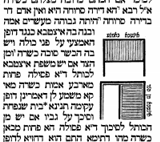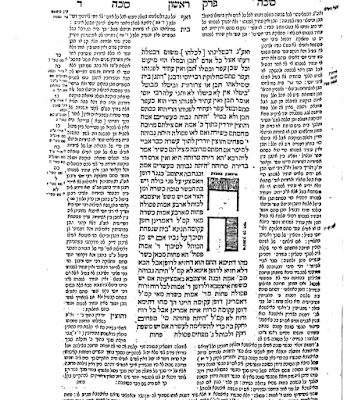Sukkah 4a “What’s Wrong with This Picture?”
Sukkah 4a “What’s Wrong with This Picture?”
By Eli Genauer
This post is is l’zecher nishmas my uncle and rebbe, Rabbi Sam Genauer ZT”L whose yahrtzeit is the second day of Av. Rabbi Genauer was a talmid of Rabbi Moshe Soloveichik at RIETS.
מסכת סוכה ד׳ עמוד א׳
The maximum height of a Sukkah is twenty Amot. The Gemara discusses a situation where the Sukkah is slightly more than twenty Amot high and one builds a raised platform inside the Sukkah.
היתה גבוהה מעשרים אמה ובנה בה איצטבא כנגד דופן האמצעי על פני כולה ויש בה הכשר סוכה כשרה
If a Sukkah was more than twenty Amot high and one built a platform (איצטבא) in it opposite the middle wall, and the platform (איצטבא) is the minimum area required for a Sukkah to be kosher, (7 Tefachim by 7 Tefachim) the Sukkah is kosher
ומן הצד, אם יש משפת איצטבא לכותל ד׳ אמות, פסולה, פחות מארבע אמות ,כשר.
And along the side wall: If there are four (or more) Amot from the edge of the platform to the opposite wall, it is Pasul. However, if there are less than four Amot, it is kosher
The Vilna Shas has two pictures embedded within the text of the Gemara which illustrate these cases. The first picture illustrates the case of איצטבא כנגד דופן האמצעי על פני כולה and the second picture illustrates the case of מן הצד איצטבא.
Updated Illustration in Vilna HaChadash (2006)
Were these two pictures part of the original text of the Talmud as written down by Rav Ami and Rav Asi?
The website Hachi Garsinan which belongs to the Freidberg Manuscript Society (https://bavli.genizah.org/?lan=heb&isPartial=False&isDoubleLogin=False) has a number of manuscripts of Gemarah Sukkah and none of them have these diagrams included within the text. They include:
British Library Harley 5508
Munich Codex heb. 140
Munich Codex heb. 95
JTS Rab. 218, JTS Rab. 1608
Oxford heb. 2. 51
It is extremely unlikely that any other written manuscript of this section of Talmud contained these two images.[1]
Nevertheless, we do get the impression from the Vilna Shas that these diagrams are part of the body of the Gemara.
The Vilna HaChadash edition (2006) even ties the two modified pictures 1) and 2) to specific words in the Gemara.
Where do these two pictures belong, if not in the body of the Gemara text?
It turns out that there are three sources (a manuscript, the Dfus Rishon of Soncino Pesaro, and Chochmat Shlomo) which point to these illustrations properly being included in Rashi’s commentary. We will then look at how they ended up in the text of the Gemara.
In a manuscript identified as JTS, New York Rab. 832 (JTS, New York, Ms. 6648), pictures illustrating איצטבא בדופן האמצעי ואיצטבא מן הצד are placed alongside two other illustrations on the next page.
Dr. Aharon Arend attributes these pictures to the Rashi on 4a.[2]
Additionally, the Dfus Rishon of Soncino Pesaro (c.1515) places the diagrams in the body of Rashi’s commentary. One diagram is situated next to the Rashi which speaks about the איצטבא being in the middle and the other diagram is in the Rashi which speaks about the איצטבא being on the side.
Bomberg Venice 1521 left empty spaces in the same two comments of Rashi. Bomberg and Pesaro clearly saw them as separate drawings and situated them in the same comments of Rashi:
This Chochmat Shlomo (Cracow 1582) agreed that the two illustrations belonged in Rashi and placed them in the Rashi immediately preceding the first one of Soncino Pesaro (which is the beginning of the Halacha):
Berman Frankfurt an der Oder 1698 used the same shapes as Chochmat Shlomo but, despite clear instructions in Chochmat Shlomo of where to place the pictures (דבור המתחיל דופן האמצעי), inserted them in the text of Gemara.
Amsterdam 1717 finally placed the two pictures where they are today.[3]
The Amsterdam imprint imputed much importance to the Chochmat Shlomo of Rav Shlomo Luria (MaHarshal) in fixing the text and format of its edition.
On the Shaar Blatt it lists the Chochmat Shlomo first in terms of what sources were used for Hagahot:
Additionally, the publisher, Judah Aryeh Leib ben Josef Samuel in his introduction to Masechet Shabbat, writes how corrupt the text of printed editions had become in his time, but that he was able to correct his edition based on the editing work of MaHarshal, MaHarsha and MaHaram Lublin. There is no diagram in Meier Einai Chachamim of MaHaram Lublin or Chiddushei Halachot of MaHarsha on this Gemara so it is most puzzling as to what source he used to overrule the instructions from MaHarshal of whom he writes ״ונתן ה׳ חכמה בלב שלמה הוא ניהו רבינו הגדול הגאון מהרש״ל זצ״ל שהגיה רוב התלמוד״
It seems as if these diagrams were somehow destined to be embedded within the text of the Gemara which is studied today, but I feel that a reference letter or number should be placed above these pictures, and an explanatory note placed on the side of the Gemara which says
בדפוס ראשון הציורים מופיעים ברש״י, ומהרש״ל גם כותב שהם שייכים לרש״י
I recommend specifically that such a notation be placed in the הגהות וציונים section of the next Oz Vehadar edition of Masechet Sukkah just as there are other references to דפוס ראשון and מהרש״ל on the same Amud.[4]
[1] According to Hillel Gershuni of the Friedberg Manuscript Society Hachi Grasinan website, none of the thousands of manuscript pages of Talmud they have studied has contained a diagram
[2] Aaron Ahrend, Rashi’s Commentary on Tractate Sukkah-A Critical Edition, Bialik Institute, Jerusalem 2021
The reference to JTS Rab 832 as Mekor Aleph is on page 27- Reference to these two diagrams pertaining to Sukkah 4a is on pages 505-506
[3] In 1714, R. Judah Aryeh Leib ben Joseph Samuel arranged to have the Talmud printed in Amsterdam by Samuel ben Solomon Marquis and Raphael ben Joshua de Palacio. They began printing with Berakhot, but were forced to discontinue printing in 1717 due to the Haskamot issued for the 1697-1699 Frankfurt on der Oder edition of the Talmud. Judah Aryeh Leib, resumed printing in 1720 in Frankfurt-am-Main at the press of Johann Koelner.































































































